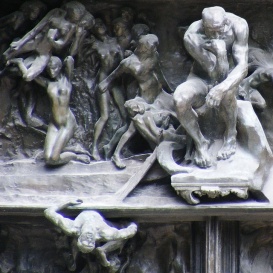A Pokol kapuja
A bonyolult, sok alakos mű kidolgozását a művész 1880-ban kezdte több központi szereplőjének megformálásával. Ezek: Ádám, és a Gondolkodó ami a 'Végítélet' jelenet központi alakja és - mint önálló szobor - Rodin legismertebb műve lett. 1881-ben Éva alakja készült el. Ezek ugyancsak a Rodin Múzeum kertjében láthatók. Később folyamatosan dolgozott a művön. Tőle származó idézet szerint mindig csak egy további hónapra lett volna szüksége a befejezéséhez.
Elkészültének dátumát az 1917-es év elejére (ami egyben halálának éve) datálják, amikor bronzba öntötték. Később a kapu modelljét bemutatták a d'Orsay Múzeumban, ill. itt helyezték el a gipsz változatot.
1937-ben került végleges helyére, a Rodin Múzeum kertjébe.
http://www.musee-rodin.fr/senf1-e.htm#porte1-e
http://www.musee-rodin.fr/senf2-e.htm
Edmond Turquet francia képzőművészeti államtitkár 1879-ben bízta meg a fiatal Rodint, hogy készítse el a Párizsi Kommün alatt 1871-ben felgyújtott egykori Orsay palota, az Államtanács és a Számvevőszék épülete helyén 1882-ben megnyitni tervezett Díszítőművészeti Múzeum főbejárati portálját. Rodin úgy döntött, hogy Dante Poklának kapuját készíti el. A hivatalos megrendelést az 1880. augusztus 16-i miniszteri rendelet tartalmazta „a Dante Isteni színjátékát ábrázoló domborművekkel keretezett díszkapura”. Két év kutatás és töprengés után készült el az első gipszminta.
Rodint csodálattal töltötte el Dante zsenije. Művének címe - A Pokol kapuja - reflektál Lorenzo Ghiberti A Paradicsom kapuja című, 15. századi alkotására a firenzei Szent János keresztelőkápolnában, csak az a firenzei költő művének harmadik helyszínén játszódó jeleneteket ábrázol az Ószövetség alakjaival. Rodin elképzelése szerint az emberek a kapuhoz közeledve szembe találják magukat a kapuval, rajta a Dante által megénekelt pokolbéli jelenetekkel: lezuhanó alakok, esdeklő bűnbánók, hiúság, árulás, paráznaság megszemélyesítői, éhhalálba küldött csecsemők, kétségbeesett életösztön, húsra éhező csontvázak stb. A kárhozottak vonaglása indafonatok szövevényeként tárul eléjük. Rodin mélyen tanulmányozta a Pokol köreit, s az évtizedeken át tartó módosítgatásokon egyre jobban átütött Dante drámaian megélt vallásossága; különösen a firenzei költő figyelmeztetése foglalkoztatta a Pokol bejárata felett: „Ki itt belépsz, hagyj fel minden reménnyel”. Dante művén kívül más ihletői is voltak, főleg Charles Baudelaire A romlás virágai c. kötete volt nagy hatással Rodinre.
A múzeum építését előbb halogatták, majd 1889-ben végleg felhagytak a projekttel, mert az ingatlanra az Orsay pályaudvart (ma múzeum) építették az 1900-as világkiállításra érkező illusztris vendégek fogadására. Rodin önmaga nem tudta finanszírozni a szoborkompozíció bronzba öntését, tovább tökéletesítette a kompozíció alakjait. A figurák számos változtatáson mentek keresztül. 1898-ban végül Rodin úgy döntött, összeállítja a mesterművet. Az 1900-as világkiállítás idején az Alma téren felállított pavilonban magánkiállítás keretében mutatta be az újabb gipszmintát, amely viszont már nem volt nyitható, s amelyről a figurális elemek egy része lemaradt. A kiállítás után ez az alkotás a pavilonnal együtt Meudonba került, ahol elemei ma is láthatók a Múzeumban.
1917-ben, röviddel Rodin halála előtt, Léonce Bénédite művészettörténész, a Luxembourg Múzeum igazgatója, a Rodin Múzeum első kurátora a művész egyetértésével összeállította A Pokol kapuját az 1899-ben előkészített öntőformák alapján. Ezt a gipsz szoborcsoportot tekintik az alkotás végleges változatának. Az 1960-as évek közepéig a Rodin Múzeumban állították ki, 1986-tól az Orsay Múzeumban látható. Ezen gipszminta alapján öntötték bronzba homokformázási technikával a kaput Alexis Rudier Öntödéjében 1925-ben, s állították össze három év alatt. A kész művet viszont csak nyolc évvel később állították ki, s 1938-ban avatták fel a párizsi Rodin Múzeum parkjában.
1926 és 1945 között a műhely további három példányt készített, melyek a philadelphiai Rodin Múzeumban, a zürichi Kunsthausban és a tokiói Nyugati Művészet Nemzeti Múzeumában láthatók. 1977 és 2015 között a Coubertin Öntöde (Saint-Rémy-lès-Chevreuse) újabb négy példányt készített viaszveszejtéses technikával, melyek az Iris & B. Gerald Cantor Vizuális Művészetek Központjában (Stanford Egyetem), a mexikóvárosi Soumaya Múzeumban, a szöuli Rodin Galériában, valamint Japánban, a Sizuoka prefektúra múzeumában találhatók.
Angol leírás, sztori
...
The Gates of Hell comprised 186 figures in its final form Many of Rodin's best-known sculptures started as designs of figures for this composition such as The Thinker, The Three Shades, and The Kiss, and were only later presented as separate and independent works. Other well-known works derived from The Gates are Ugolino, Fugit Amor, The Falling Man, and The Prodigal Son.
The Thinker (originally titled The Poet, after Dante) was to become one of the most well-known sculptures in the world. The original was a 27.5-inch (700 mm)-high bronze piece created between 1879 and 1889, designed for the Gates' lintel, from which the figure would gaze down upon Hell. While The Thinker most obviously characterizes Dante, aspects of the Biblical Adam, the mythological Prometheus. and Rodin himself have been ascribed to him. Other observers de-emphasize the apparent intellectual theme of The Thinker, stressing the figure's rough physicality and the emotional tension emanating from it."
http://en.wikipedia.org/wiki/Auguste_Rodin#The_Gates_of_Hell

"A Pokol kapuja" c. alkotás fotói
ƒ40/10 • 1/220 • ISO64
Felhasználási jogok
Vízjel nélküli változatra van szükséged? A megadott felhasználhatóságtól eltérően használnád a fájlt? Kérj egyedi engedélyt a feltöltőtől!

"A Pokol kapuja" c. alkotás fotói
ƒ40/10 • 1/170 • ISO64
Felhasználási jogok
Vízjel nélküli változatra van szükséged? A megadott felhasználhatóságtól eltérően használnád a fájlt? Kérj egyedi engedélyt a feltöltőtől!

"A Pokol kapuja" c. alkotás fotói
ƒ35/10 • 1/180 • ISO200
Felhasználási jogok
Vízjel nélküli változatra van szükséged? A megadott felhasználhatóságtól eltérően használnád a fájlt? Kérj egyedi engedélyt a feltöltőtől!

"A Pokol kapuja" c. alkotás fotói
ƒ35/10 • 1/180 • ISO200
Felhasználási jogok
Vízjel nélküli változatra van szükséged? A megadott felhasználhatóságtól eltérően használnád a fájlt? Kérj egyedi engedélyt a feltöltőtől!

"A Pokol kapuja" c. alkotás fotói
ƒ35/10 • 1/180 • ISO200
Felhasználási jogok
Vízjel nélküli változatra van szükséged? A megadott felhasználhatóságtól eltérően használnád a fájlt? Kérj egyedi engedélyt a feltöltőtől!

"A Pokol kapuja" c. alkotás fotói
ƒ35/10 • 1/180 • ISO200
Felhasználási jogok
Vízjel nélküli változatra van szükséged? A megadott felhasználhatóságtól eltérően használnád a fájlt? Kérj egyedi engedélyt a feltöltőtől!








